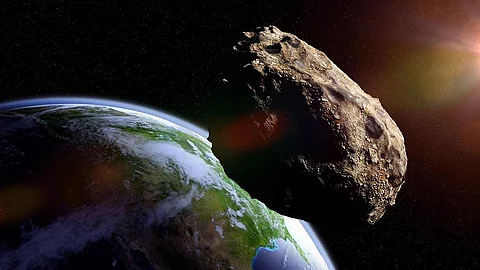

Earth’s continents were formed by massive meteorite impacts that were prevalent during the first billion years of our planet’s four and a half billion-year history, according to a new study.
Meteorite impacts generated massive energy to form oceanic plates, which later evolved into continents, the study published August 10, 2022 in Nature journal found.
The most commonly accepted theory in place attributes continent formation to the movement of tectonic plates.
The theory that giant meteorite impacts formed continents had been around for decades, but until now, there was little solid evidence for its support.
The new study provides some concrete evidence supporting the big impact theory, Tim Johnson, deputy head of Curtin University, told Down To Earth.
The researchers looked for evidence in zircon crystals embedded in rocks from the Pilbara Craton in Western Australia. This craton is the remnant of an ancient crust that began forming more than three billion years ago.
Zircons are formed by the crystallisation of magma or are found in metamorphic rocks. They act as tiny time capsules, recording the period of geologic activity, according to the American Museum of Natural History. Newer zircon adds to the original crystal as time progresses, it said.
Johnson and his colleagues studied the variants or isotopes of oxygen within these crystals: oxygen-18 and oxygen-16. The ratio between the two variants helped scientists estimate past temperatures.
Older grains of zircon possessed the lighter oxygen-16. The younger ones contained the heavier oxygen-18.
“This pattern suggests the Pilbara Craton began with extensive melting of shallow, near-surface rocks, with subsequent melting occurring at successively deeper levels, Johnson explained.
The giant meteorite hit Earth and melted the outer shell of the Earth or the lithosphere, according to the study.
This impact released the pressure on the underlying mantle. As a result, the mantle likely melted, creating an oceanic plateau.
This is similar to a lump forming after being struck on the head by a stone or a cricket ball, according to the expert.
“If the oceanic plateau gets big enough, it can melt at its base to form granite, which is what the continents are made of,” he added. Granite requires both water and energy to form.
Other rocky planets and the moon have had a history of meteorite impacts. But they had little or no water by the time the flux of effects declined, Johnson pointed out.
Understanding the formation and evolution of continents is important as it is the key to reserves of metals such as lithium, tin and nickel, which are required to develop batteries, the study noted.
The expert added that shallow melting of the rocks separates the lower density elements, such as lithium, from the higher density ones, such as iron.
Eventually, the lower density elements rise to the surface as a granitic continental crust.
Johnson and his team think other areas containing ancient continental crusts also have a similar pattern, like the Pilbara Craton in Western Australia.
“We would like to test our findings on these ancient rocks to see if, as we suspect, our model is more widely applicable,” he added.